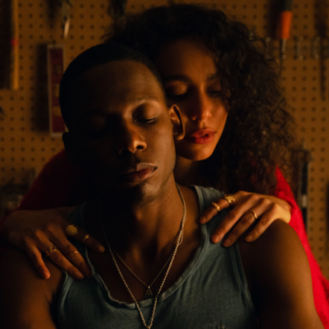Until recently, when she was cast in the third season of HBO’s hit series Succession, Dasha Nekrasova was one of those niche internet celebrities that enjoys considerable notoriety in select circles while remaining virtually unknown in the larger public consciousness. She is perhaps best known as the co-host of the popular left-leaning podcast, Red Scare. Much like her podcast, Nekrasova’s debut directorial feature is calculated to invite controversy. Brash and antagonistic, The Scary of Sixty-First bills itself as a horror-thriller inspired by Jeffery Epstein – but the film does more than simply draw inspiration from the American investor and convicted sex offender. In fact, Epstein’s crimes (and his death) are the foundation of The Scary of Sixty-First’s meager plot.
The film follows two young women, Noelle, played by Madeline Quinn (who co-wrote the script with Nekrasova), and Addie (Betsey Brown), who manage to score a deal on a furnished apartment in Manhattan. Sure, there are a few red flags, such as a mirror on the ceiling in one of the rooms and a couple of very oddly placed locks, but the girls consider themselves lucky to have found such a place at a reasonable price. Shortly after they move in, however, a stranger known only as “the girl” (Nekrasova) arrives and informs Noelle and Addie that their new home used to belong to Jeffery Epstein – and was likely the location of some of his crimes.
The news leaves both women shaken. As Noelle and the girl delve into a maddening online world of YouTube videos and conspiracy theories, Addie begins to lose her grip on reality in a different way. Brown gives this performance everything she has, and it is gut-wrenching. Addie is terrifying. Her obsession with Epstein takes on a perverse, sexual aspect that is both nauseating and pitiful. While the film is never completely clear about exactly what motivates Addie’s unhinged behaviour, it is truly harrowing to watch.
The Scary of Sixty-First is the sort of psychological horror film that makes heavy use of overlapping, juxtaposed images to create a sense of unease. The old-school, vintage feel of the film – despite its contemporary subject matter –inspires dread from the very beginning. Stylistically, there are obvious allusions to the work of directors such as Roman Polanski and Stanley Kubrick (think Eyes Wide Shut and Rosemary’s Baby). We open on architecture: ornate marble cherubs and gargoyles adorn a New York city mansion. It is decidedly sinister, and ties in nicely with the film’s exploration of trauma and place. People may forget (or want to forget) the terrible things that happened here, but the building itself remembers.
As the film goes on, however, it becomes more and more difficult to discern the method in Nekrasova’s madness. The images on screen are certainly shocking and uncomfortable, but I was left wondering what all that shock and discomfort was for. For as accomplished as The Scary of Sixty-First is, it feels uncertain of its own purpose or message. At various points, the film touches upon paedophilia, conspiracy theories, substance abuse, mental illness, economic class, religion, sexual kinks, the occult, and the rental market crisis. As though someone tossed together a random sample of trending topics on Twitter. The resulting viewing experience feels like falling down an amphetamine-fueled rabbit hole through variously twisted and mundane corners of the internet.
Is it enjoyable? Not particularly. Would I subject myself to it again? Probably not. Did the repeated, direct, and unveiled references to Epstein feel both ill-advised and in poor taste? You bet. That said, I left The Scary of Sixty-First desperately wanting to talk about it with someone, anyone. This is the kind of movie that demands discussion, conversation, and debate.
The investigation into Epstein and his trial, sentencing, and death in 2019 brought public attention to his monstrosity and raised serious questions about the role power, wealth, influence, and empire play in shielding the elite from justice – questions that will likely never be answered. In the end, the only way I can think to make sense of The Scary of Sixty-First is not as a story with a plot and characters per-say but as a sort of impressionistic snapshot of an emotional response to a very specific cultural and historical moment. A feeling—a nightmare—caught on film.
**********
Do You Tweet? Follow These Tweeple:
Shannon Page: @ShannonEvePage





Be the first to comment